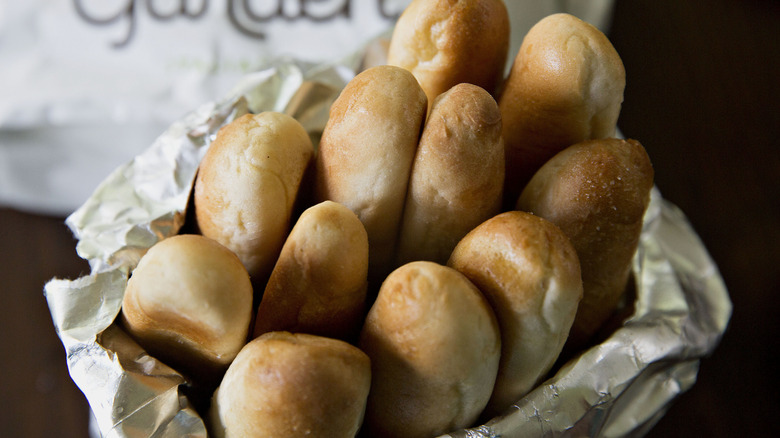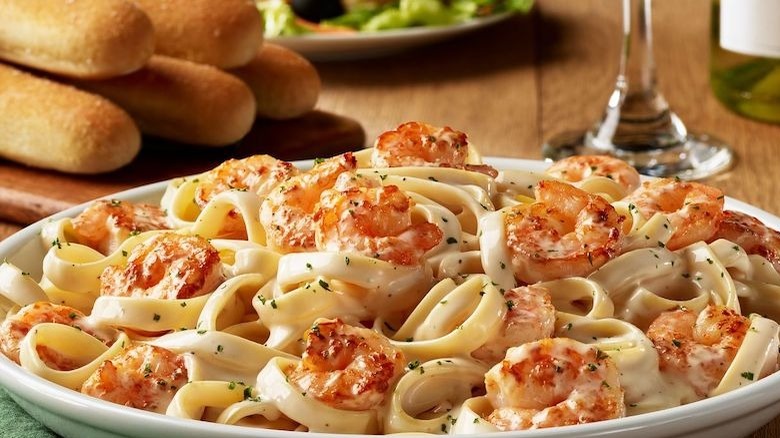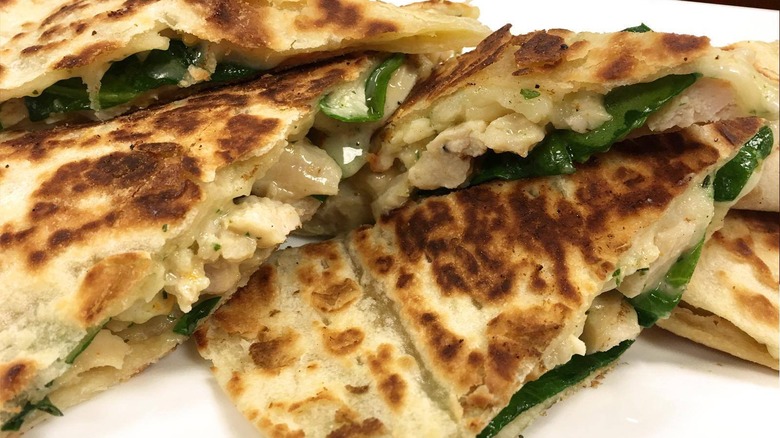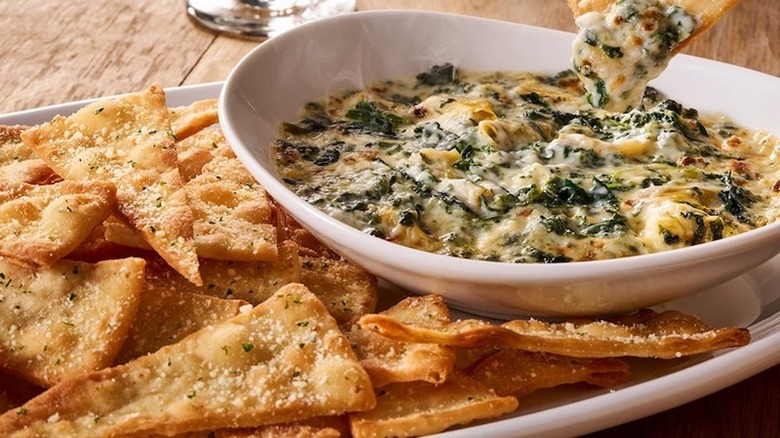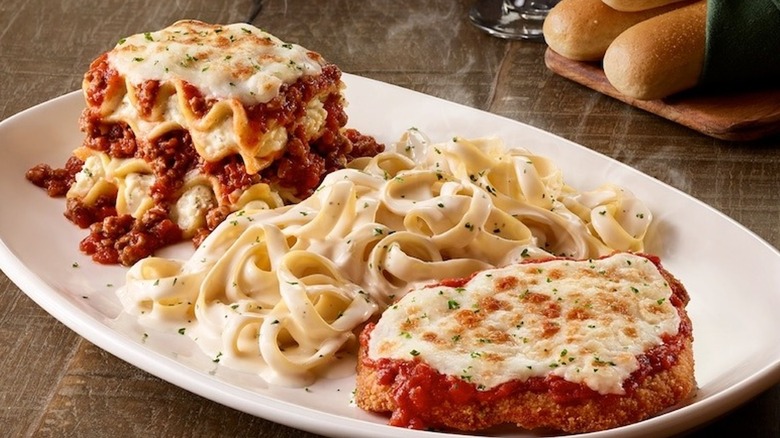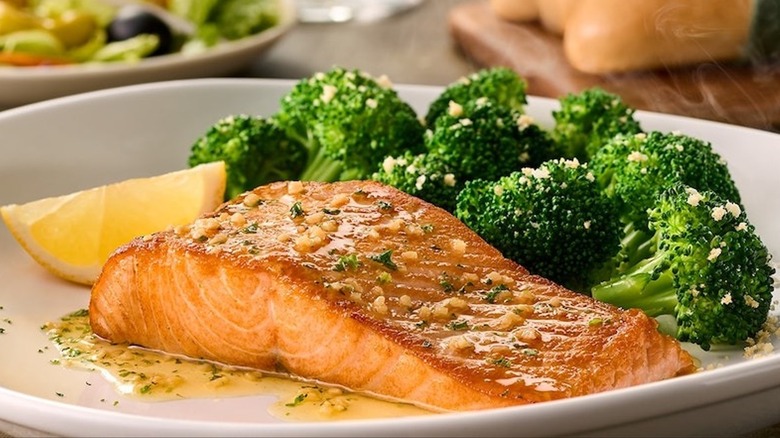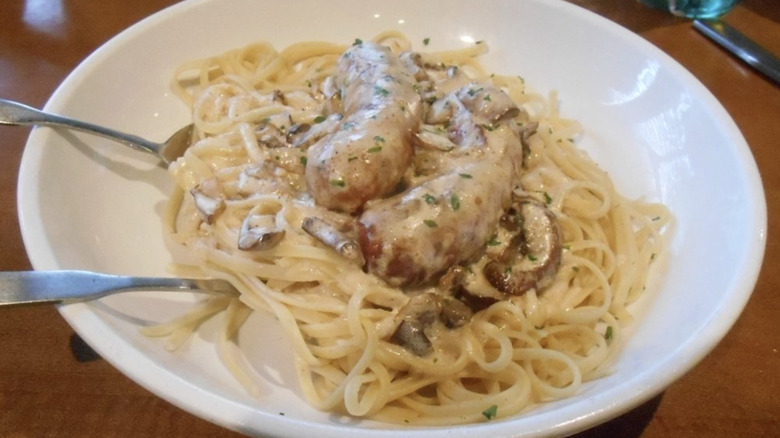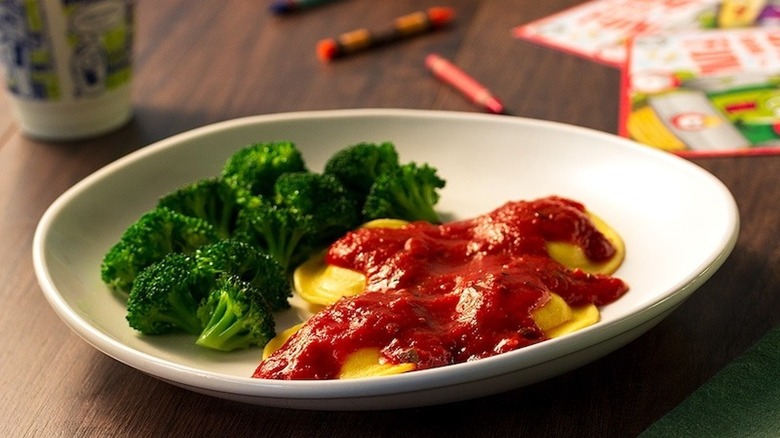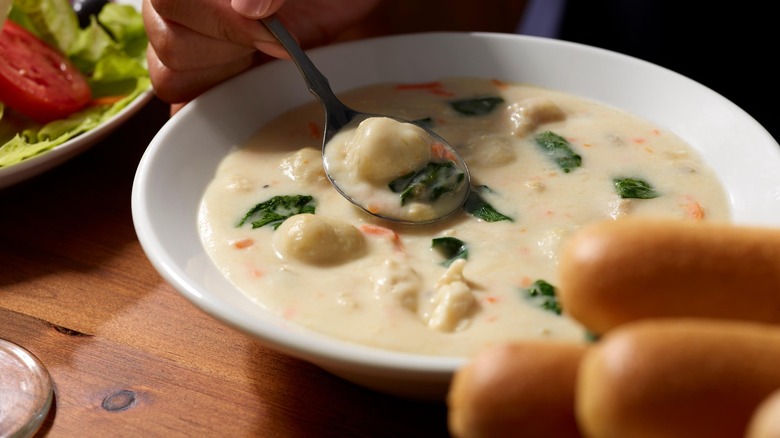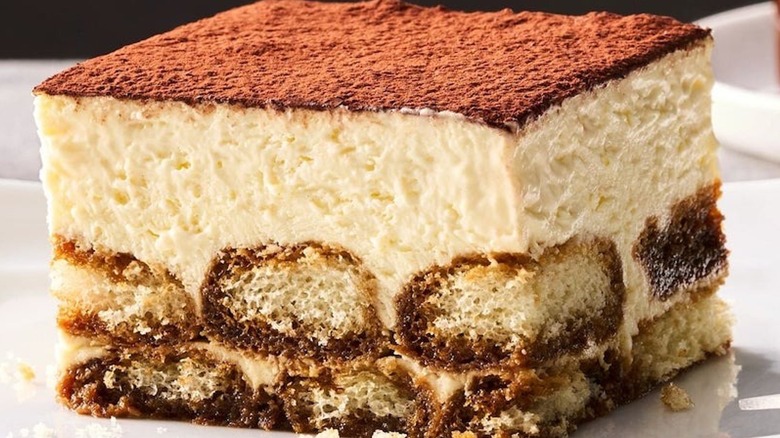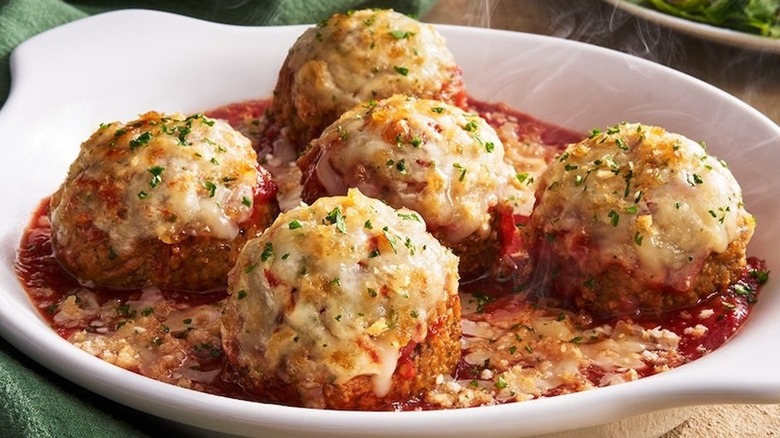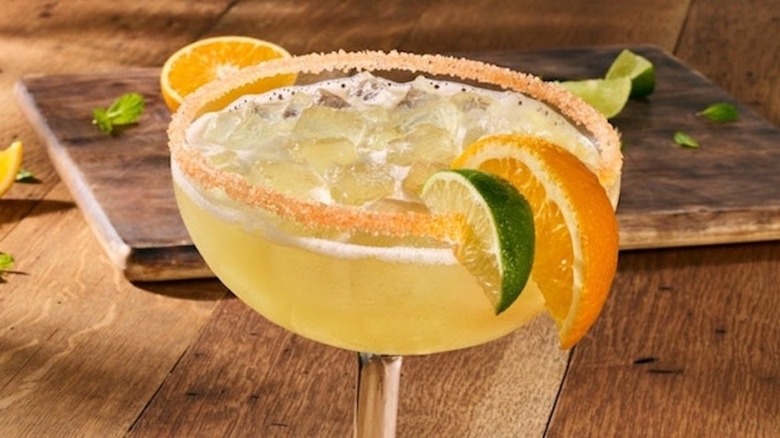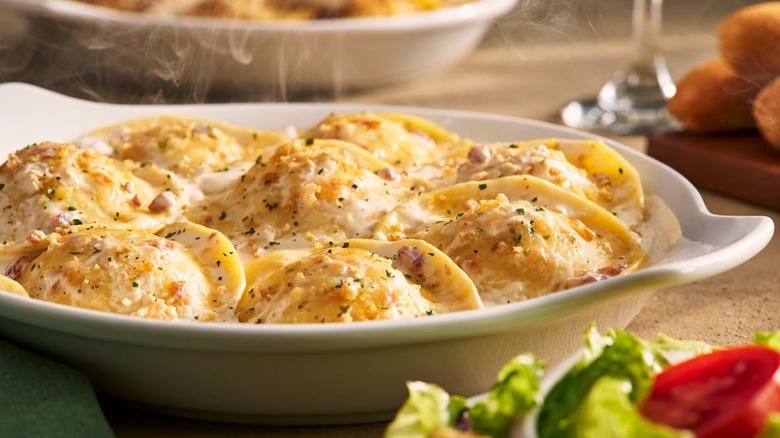14 Foods You Might Want To Avoid Ordering At Olive Garden
Olive Garden may specialize in serving up Italian-style food, but it's an American institution. Since 1982, Olive Garden has devoted itself to offering Italian dishes at an affordable price, and in just over 40 years has grown to an enormous size, with almost 900 restaurants and nearly 100,000 employees. And the evolution of the Olive Garden menu over the years has shown that it's a business that embraces change.
In the early years, the restaurant's menu was more traditional, offering dishes like mussels di Napoli and veal piccata, nowadays it focuses on combining Italian sensibilities with American ones, offering a host of dipping sauces and ever-popular creamy pasta dishes. But while some of those changes may have allowed it to embrace a broader appeal, not all of them were for the better. Olive Garden's current menu has a host of options that, unfortunately, fall short of the mark.
In this article, we focused on highlighting the main foods you might want to avoid due to nutritional value, cost, and taste. Some of that info we gathered from Olive Garden's website itself. Other info comes from the experiences of customers, or current and former Olive Garden employees, who've shared their experiences.
1. Shrimp Alfredo
Olive Garden's Alfredo dishes are a staple of its menu, and its Shrimp Alfredo is one of its most popular. But while it's a solid choice, it's also one you'll pay over the odds for. "One of the worst values on the menu is the shrimp Alfredo. You'll pay $18 for the dish when you can create your own shrimp pasta with cheese sauce for less," an Olive Garden server told Insider. Instead of ordering the Alfredo dish, opt for the restaurant's Never Ending Pasta Bowl, and you can have Alfredo sauce, shrimp, and pasta in a similar dish for less money.
And even if the price of the Shrimp Alfredo didn't put you off, its nutritional value just might. This dish is astonishingly high in saturated fat, containing 55 grams, making the majority of its 93-gram fat content saturated. It's worth remembering that the recommended daily saturated fat allowance for individuals following a 2,000-calorie diet is approximately 16 grams, as suggested by Brigham and Women's Hospital Department of Nutrition Director Kathy McManus (via Harvard Health Publishing). By ordering the Shrimp Alfredo as an entrée, you'll get almost 350% of that allowance in a single meal.
2. Chicken Piadina
Olive Garden has offered a range of sandwiches over the years to cater to its lunchtime clientele, and its Piadina sandwiches look at first glance like some tasty choices. This flatbread sandwich is almost like an Italian quesadilla, stuffed with proteins like prosciutto, chicken, and cheese. It's then toasted until warm and comforting.
But appearances can be deceiving. Olive Garden's Chicken Piadina is a tasteless, greasy affair, with its bread swimming in oil and its meat poorly proportioned with its clumps of cheese. While the sandwich does have some added vegetables to give the air of nutrition, these are few and far between. The same issue occurs with its Veggie Piadina, which has barely any vegetables to speak of and is instead made up mainly of cheese and oil.
While we admire Olive Garden for serving up an Italian sandwich style that may not be as familiar as others and encouraging its customers to try new things, unfortunately, the execution just isn't there. You can likely find a way better sandwich at any other restaurant in town — and when Olive Garden's Soup, Salad, and Breadsticks lunchtime deal is so well-established and so reasonably priced, why would you pick anything else?
3. Spinach-Artichoke Dip
The spinach-artichoke dip has been on Olive Garden's menu for a while now, and when ordered as an appetizer, it comes alongside a generous portion of flatbread crisps. But even if you're sharing this dish with friends, you might want to take note of its nutritional value. This appetizer has 2,440 milligrams of sodium and 1,160 calories, making it one of the saltiest appetizers on the menu, as well as the second-most calorific — it's beaten by the Shrimp Fritto Misto, which has 1,280 calories.
Unlike the shrimp dish, though, the spinach-artichoke dish also has a full gram of trans fat. Trans fats are uniquely harmful to health because they have a doubly damaging effect on cholesterol. Consuming them raises bad LDL cholesterol and lowers good HDL cholesterol, thereby limiting your body's ability to limit LDL build-up, says UCLA Medical Center senior dietitian Dana Hunnes via Prevention. In addition to this, trans fats can cause a higher level of inflammation and damage to your blood vessels. This is particularly disappointing given that this appetizer is primarily made with healthy ingredients like spinach and artichoke, which can give the impression that it's more nutritious than it actually is.
4. Tour of Italy
If you're unsure of what to order at Olive Garden, the Tour of Italy can seem like a smart choice. The entrée combines three classics in one meal, giving you a Lasagna Classico, a Fettuccine Alfredo, and a Chicken Parmigiana — and despite giving you a trio of options, it remains a similar price to the other dishes on the menu.
But the Tour of Italy also gives you a pretty unhealthy plate of food. Each order comes with a massive amount of sodium, delivering 3,220 milligrams per portion, way more than the total amount you should be eating in a day, according to Mayo Clinic. It also has 1.5 grams of super-unhealthy trans fats. And perhaps unsurprisingly, given the amount of food you get, it's also very high in calories, providing 1,550 in each plate. We do, of course, need calories to survive and fuel our bodies, but on average, women should be aiming for 2,000 a day to maintain their body weight, with men aiming for 2,500, according to the National Health Service. When you go significantly above this (which is easily done if you're consuming calorie-dense options like this one), you raise the risk of obesity, which can lead to a slew of physical and mental health considerations, according to research published by StatPearls.
5. Herb-Grilled Salmon
With a menu that's awash with creamy, heavy options, the herb-grilled salmon at Olive Garden feels like a breath of fresh air. This dish combines healthy, omega-3-rich salmon with a side of broccoli, and by grilling it instead of frying, it steers clear of the high-fat content that other Olive Garden menu options have.
But while these things are all positives, what's less exciting is the dish's sheer quality. "There's a reason Olive Garden is better known for their pasta than their seafood. The salmon comes in frozen and, in my opinion, this dish is only on the menu to add some diversity," explains one former Olive Garden employee via Insider.
It's worth noting that, according to Seafresh, frozen fish is no less nutritious than fresh fish, and nor is it the case that it's lower quality or less tasty. Restaurants often rely on using frozen fish over the fresh kind as a way to ensure the protein's quality when it arrives on-site. However, the fact that the workers themselves at the restaurant don't love the dish suggests that there are other options on the menu that are fresher or more worth your money, like the shrimp-based options. As well as this, the fish may lack the zingy, salty freshness that newly-caught fish has in abundance, and instead may taste flat and processed.
6. Pasta with Creamy Mushroom sauce
Olive Garden's Never Ending Pasta Bowl is a firm favorite, and for many it represents the ultimate in value, allowing you to grab as much pasta, with your choice of sauces and toppings, as you like for a set price. But watch out if you opt for the Creamy Mushroom sauce with your order. This sauce is laden with calories, fat, and saturated fat, with a single bowl delivering 860 calories, 87 grams of fat, and 54 grams of saturated fat. And that's all before you take any toppings into account.
The saturated fat content is particularly concerning, considering that it could be triple the amount that some people need in a full day, according to Harvard Health Publishing. Eating too much saturated fat can cause your cholesterol levels to rise, which may also increase your risk of heart disease. Remember, too, that Olive Garden's Alfredo sauce, also available in its Never Ending Pasta Bowl, is just as fat-heavy and calorific. To make a healthier choice, opt for the Marinara or Meat sauce with your pasta bowl, which have 150 and 300 calories respectively, and go for the Chicken Fritta topping instead of the meatballs or Italian sausage, both of which are high in saturated fat.
7. Kids Cheese Ravioli
For kids, Olive Garden is a winner. The restaurant offers a selection of straightforward, tasty dishes for kids that they're likely to eat without much fuss. Unfortunately, though, some of its kids' options, like its Kids Cheese Ravioli, have nutritional values that are pretty unattractive. The Kids Cheese Ravioli is abundant in sodium, containing almost 1,000 milligrams. This would be a high amount in an adult's meal, but for kids, it's especially worrying. Excessive sodium intake in children can lead to higher rates of high blood pressure and obesity, according to a 2020 study published in Paediatrics & Child Health, which may set them up for poorer health outcomes later in life.
Several other options on the kids' menu, like the Cheese Pizza, will also provide hefty amounts of sodium, and can also be pretty calorific. If you want to keep things on the less salty side, the best choice is to go for a bowl of pasta with tomato sauce, with added shrimp for protein. The Olive Garden chicken fingers are also relatively low in sodium, although, with 580 milligrams, it's still not salt-free.
8. Wine
In our opinion, no Italian meal is complete without wine. And that's clearly Olive Garden's opinion too, with the restaurant offering a range of wine options with every meal. However, according to a former Olive Garden employee, the wine should always be avoided. The employee revealed via Quora that the wine options at the restaurant are overpriced, with customers paying above the odds for what could be a substandard vintage.
This is especially notable considering that you can bring your own wine to Olive Garden and save a ton. Not everybody knows that some Olive Garden branches have a BYOB option, allowing you to bring your favorite bottle, which you could have bought at half the price in the store next door. The corkage fee at Olive Garden is usually $7, so it's important to make sure that the price of your bottle plus corkage doesn't cancel out any savings that you might be making by bringing your own. On the plus side, though, bringing your own bottle eliminates the risk of choosing a wine that you might not like or having to pay a high price for glass-by-glass orders.
9. Chicken & Gnocchi soup
The Chicken & Gnocchi soup is a staple of Olive Garden's menu, and it's little wonder why. This simple soup is a favorite amongst customers and offers them a hearty meal at a reasonable price. But one of the reasons it's so delicious is because it's absolutely crammed with sodium. Olive Garden's Chicken & Gnocchi soup has 1,290 milligrams of sodium in its 230 calories of food. This makes it far and away the saltiest soup option on its menu, with only the region-specific Stellini Soup coming close, with 1,240 milligrams of sodium.
It's a huge amount of sodium for such a comparatively light meal, and eating it will mean that you consume over half of your daily value of 2,300 milligrams per day in one bowl. But it's also worth remembering that the daily value of a nutrient exists at the higher end of the spectrum, as it's a number that applies to everyone, regardless of body composition. Since this daily sodium maximum may even be too high for some people, you should consume this soup sparingly.
10. The desserts
Like any respectable restaurant, Olive Garden has a range of sweet options for you to enjoy at the end of your meal. While the desserts can vary, they're predominantly Italian-themed, with choices like Sicilian Cheesecake and Tiramisu routinely available. Just don't expect them to be super fresh. While many Olive Garden menu options are made on-site, the desserts are always shipped into the stores pre-made, according to an employee via Quora.
This doesn't necessarily mean that the desserts are going to be bad as a result of this. Making good desserts, after all, can take way more time and skill than your average savory meal, and having them shipped in means that they arrive at the restaurant with that work already done. What it does mean, though, is that you might be eating a dessert that has been sitting around for a while — while other items are made to order, ensuring maximum freshness, you might end up with a slice of cheesecake that's been in the fridge for a few days. It also means that the desserts are perhaps more likely to contain ingredients like additives and preservatives to prolong their shelf life, which might not be added if they were made fresh.
11. Meatballs Parmigiana
Few things hit the spot like Meatballs Parmigiana. While the dish is often served as a main course, Olive Garden takes the somewhat unique approach of offering it as an appetizer, with the individual meatballs being easily split up amongst friends. You might want to keep an eye on its nutrient levels, though, because this appetizer is both full of saturated fat and hugely salty. Each plate of Meatballs Parmigiana contains 40 grams of saturated fat, more than double the upper limit that a single adult should be eating daily, and 2,800 milligrams of sodium, again way over the daily value.
Now, obviously, this option is designed to be split up amongst several people — but that's no excuse, given that other choices on the menu don't contain nearly as much sodium or fat. These ingredients, especially sodium, are added to enhance the flavor of restaurant foods, and also have a preserving effect, allowing eateries like Olive Garden to keep their food for longer. However, making a habit of over-consuming sodium can lead to some negative health effects. Amazingly, too, the Meatballs Parmigiana isn't the saltiest appetizer that Olive Garden has. That ignoble distinction goes to its Shrimp Fritto Misto, which has a stunning 5,010 milligrams of sodium.
12. Five Cheese Ziti al Forno
Olive Garden's menu isn't short on cheesy dishes, and the Five Cheese Ziti al Forno is probably the cheesiest they've got. But even cheese lovers might want to steer clear of it, for the sheer fact that it's just not very good. In a survey conducted by Mashed, which asked almost 650 people which Olive Garden entrée they liked the least, almost a quarter of all the respondents said the Five Cheese Ziti al Forno was the one to avoid. This put it several percentage points above the next least-loved dish, the Shrimp Alfredo.
While there were few clues as to exactly why people voted the Five Cheese Ziti al Forno as their least favorite, we'd say that the dish is just too overwhelming. A meal using one or two cheeses allows the individual subtleties of the dairy products' flavors to stand out, but when five are thrown in, it just feels like you're being pummeled with lactose, and any nuance is lost. And the dish's nutritional content may also have something to do with it. When ordered as a dinner entrée, the Five Cheese Ziti al Forno has almost 1,200 calories, with 36 grams of saturated fat, 1.5 grams of trans fat, and 2,440 milligrams of sodium.
13. Italian Margarita
We all love a cocktail, and Olive Garden has quite a few to choose from, with Italian-style options like the Amaretto Sour, Blue Amalfi, and Italian Rum Punch. Its Italian margarita is a twist on the tequila-based classic, combining the spirit with triple sec, and then topping it with a splash of Italian amaretto.
It's certainly delicious — but it's also loaded with sugar. One single Italian margarita has a massive 49 grams of sugar. This sugar appears to come from the combination of triple sec and amaretto, both liqueurs that have a fair amount of it, with a shot of each containing 11 grams. While Olive Garden doesn't mention adding syrup to its margaritas on its website, it's also possible that further sweetness is added to make the drink more palatable.
This sugar also raises the calorie count of the cocktail, giving it 380 calories per glass. If you're following a 2,000-calorie diet, the sugar content could cover pretty much the entirety of your recommended daily limit of 50 grams, with the calorie content amounting to almost 20% of your daily allowance, according to Loyola Medicine. This is all in a drink that provides no protein, no fiber, and no nutrients to speak of.
14. Ravioli Carbonara
Everyone's favorite stuffed pasta shows up in a few forms on Olive Garden's menu, with Toasted Ravioli as an appetizer and Cheese Ravioli as an entrée. But it's the Ravioli Carbonara that really caught our eye — and not in a good way. This dinner entrée is one of the unhealthiest things you can choose when at Olive Garden. The baked pasta dish, which has cheese both inside and outside its shapes, has 1,390 calories and 63 grams of saturated fat. But even more worryingly, it contains 2.5 grams of trans fats.
Trans fats can be naturally occurring and often show up in dairy products, so it's not surprising that this cheese-heavy dish has so many. But crucially, we don't really need trans fats at all to survive, and even small amounts can be bad for us. So the fact that this meal has such a high amount, when many other Olive Garden menu items don't have any at all (including a fair few cheese-based dishes, like its cheese ravioli with marinara sauce), makes it one you really should skip. If that wasn't enough to make you order something else, the dish also has 2,660 milligrams of sodium — way more than you need in a full day.
Static Media owns and operates Daily Meal and Mashed.
